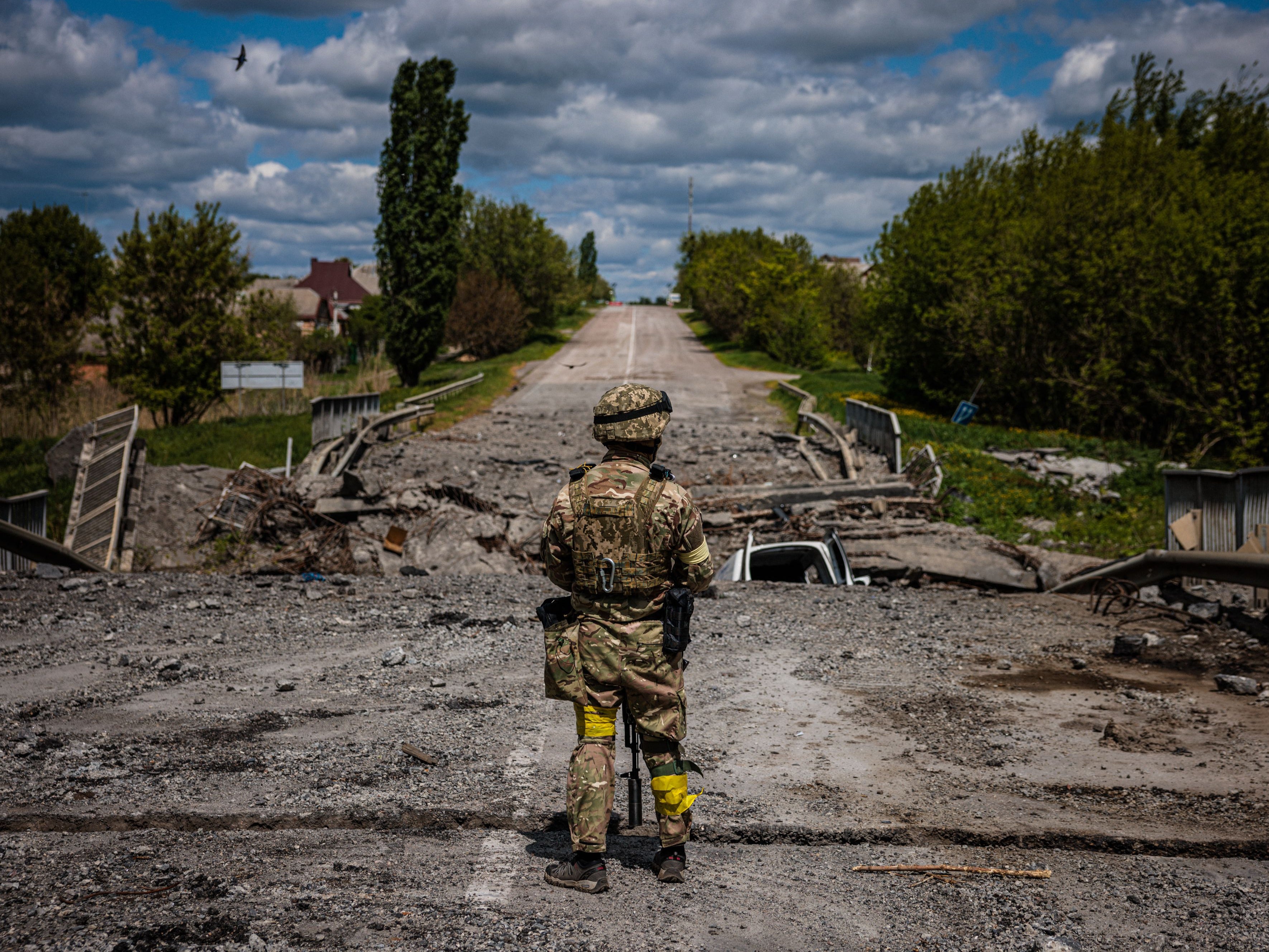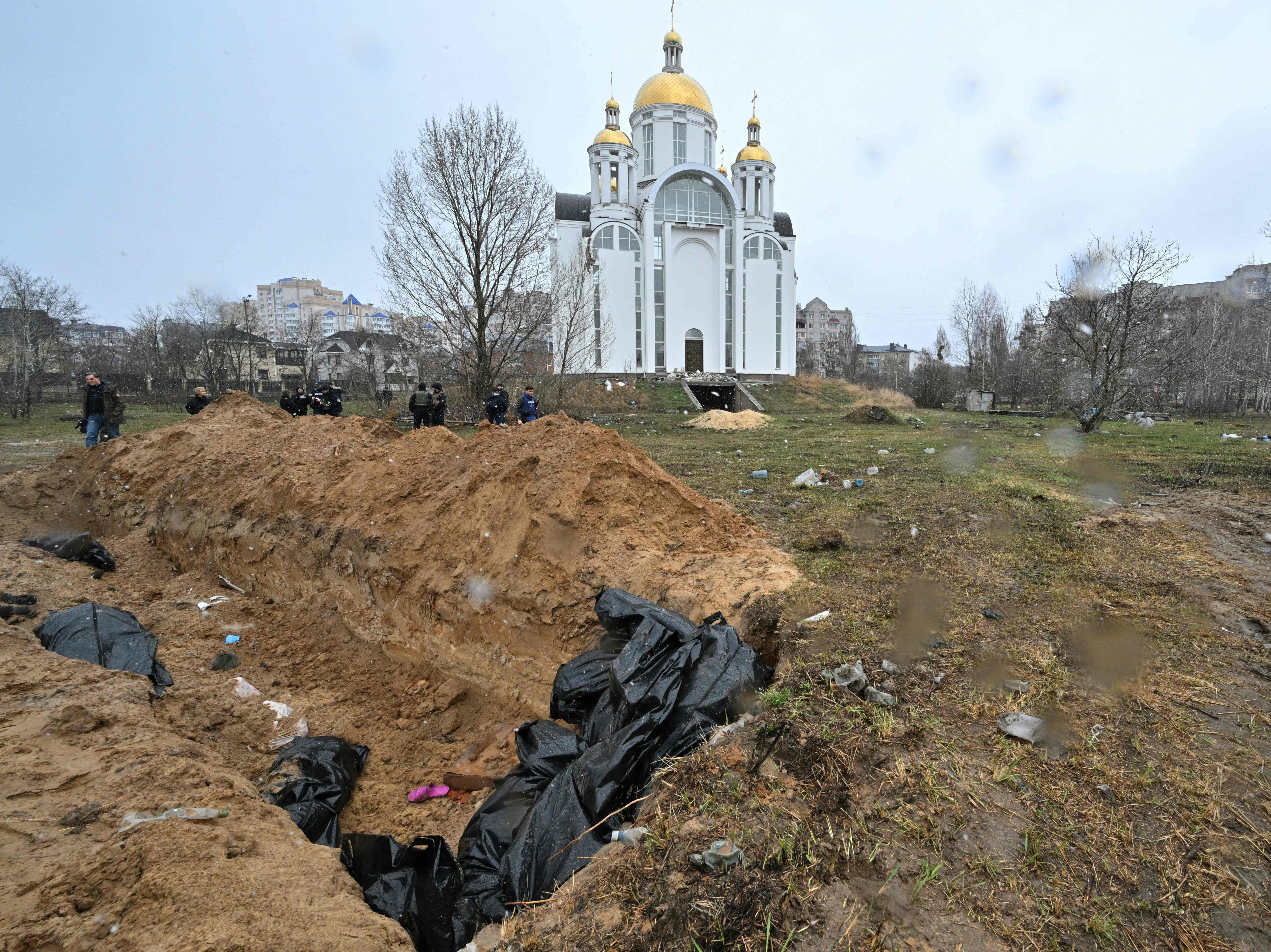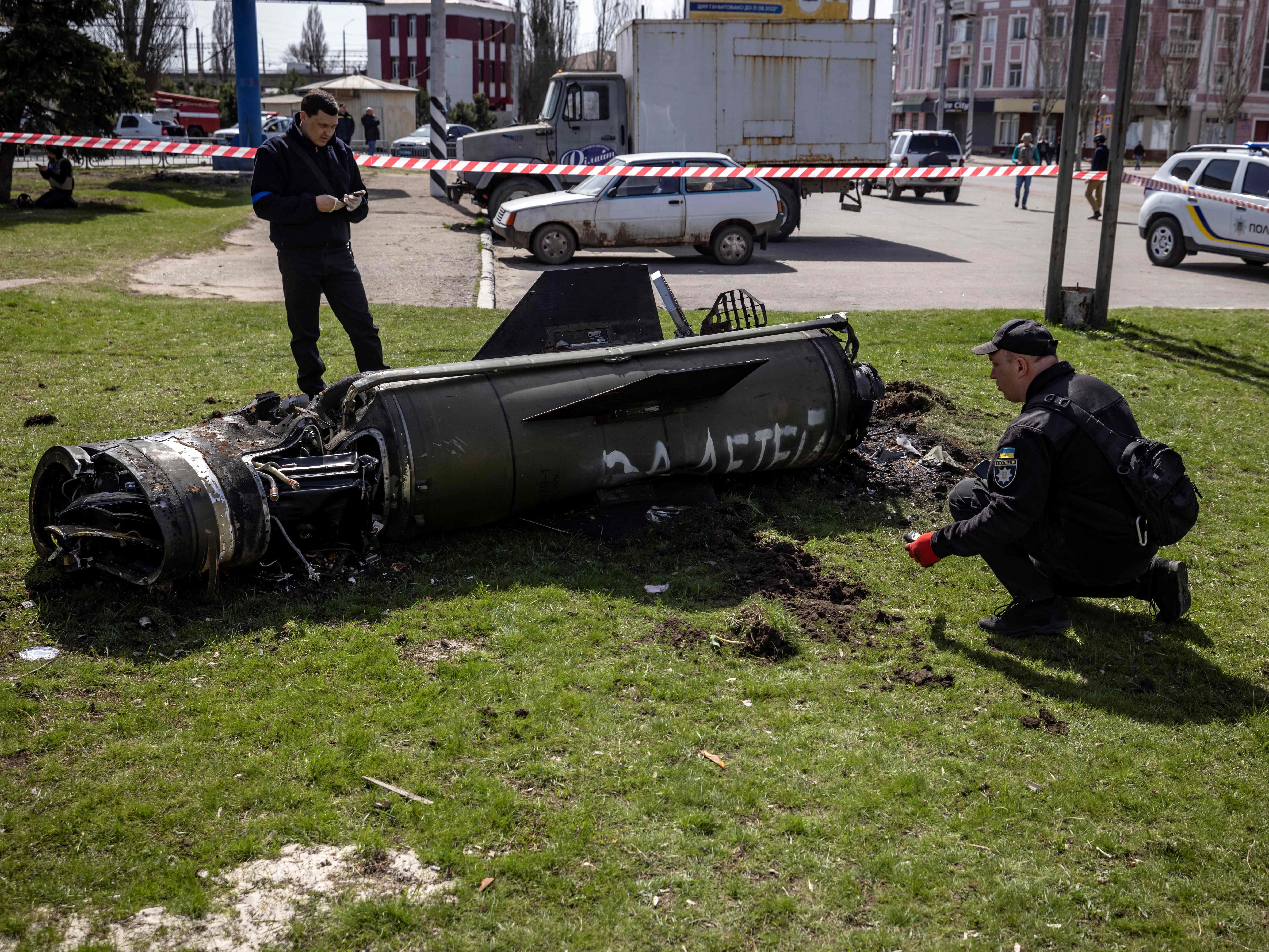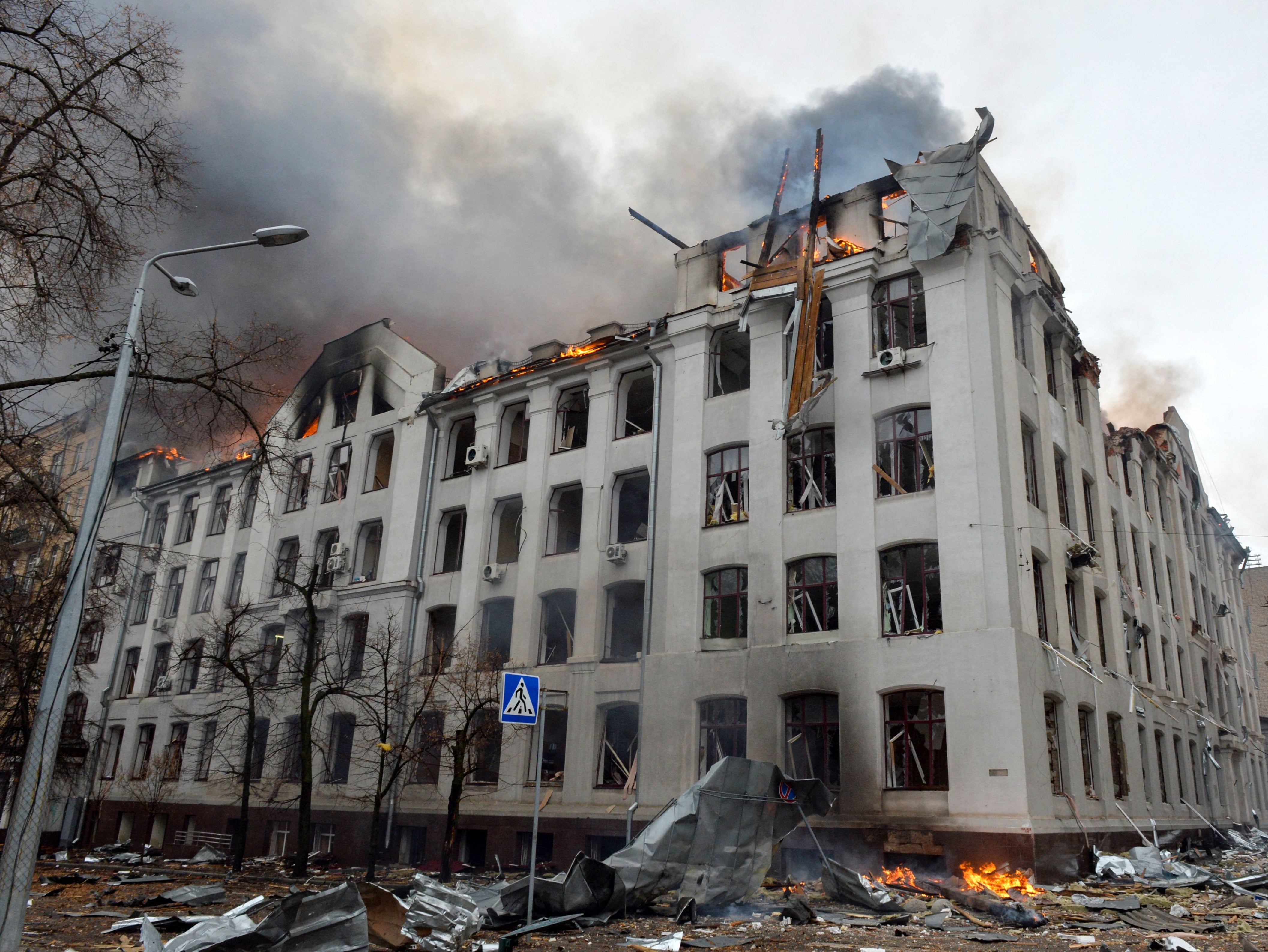100 days of war: How the invasion of Ukraine unfolded and left thousands dead
The Independent looks back at the key moments and atrocities from the first 100 days of warfare

One hundred days of warfare between Ukraine and Russia have now passed – a tragic milestone in a conflict that has claimed tens of thousands of lives, displaced millions from their homes, razed cities, towns and villages to the ground, and reshaped the geopolitical contours of Europe and the wider world.
The initial shockwaves that followed Vladimir Putin’s declaration of war on 24 February – described as a “special military operation” by the Russian president – have long since dissipated, with the people of Ukraine committed to carrying on with their lives under the looming spectre of warfare.
The fighting itself has shifted eastward in the country, which has become the new focus of Putin’s war machine, after attempts to overwhelm the capital, Kyiv, and topple the Ukrainian government were unsuccessful.
Ukraine’s resilience on the battlefield has proved decisive. Despite Russia’s strength in numbers, the defending forces have used their knowledge of the land and astute military tactics to chip away at Putin’s invaders, stalling and disrupting their efforts to conquer the country in one quick sweep.
Western allies of Kyiv have played their part, too, in equipping the Ukrainians with state-of-the-art military equipment to counter Russia’s superiority in the air and on the land, while the imposition of sanctions has alienated the Kremlin and its economy, turning the country into a pariah state.
Still, Ukraine’s success in resisting Putin has come at a cost. President Volodymyr Zelensky has conceded that his forces are now suffering up to 100 fatalities and 500 casualties every day, as fighting in the east becomes more concentrated and laborious. Given the slow advance of Moscow’s troops, officials fear the war could grind on to the end of the year.

This raises the prospect of more deaths, more displacement and more suffering for a country whose soul has been blackened by the largest conflict of its kind since the Second World War. In total, at least 46,000 lives have been lost between both sides, including thousands of civilians, while 6.8 million Ukrainians have fled the country, billions worth of damage has been inflicted, and a looming global food crisis is emerging because of disruption to Ukraine’s wheat exports.
Here, we look at the key moments and atrocities from the first 100 days of warfare:
A ‘special military operation’
24 February: The first bombs fell in Kyiv, Kharkiv, Odesa and the Donbas, just minutes after Putin announces to the world that a “special military operation” has been launched in Ukraine, one that sought to “demilitarise” and “denazify” the country, but not occupy it.
This came after months of speculation about Russia’s intentions after it massed tens of thousands of troops on Ukraine’s border. Despite Putin’s words, officials from both inside and outside Ukraine were under no illusions as to what had begun.
“This is a war of aggression,” says Dmytro Kuleba, Ukraine’s foreign minister. “Ukraine will defend itself and win. The world must act and stop Putin. It is time to act – immediately.”

The operation’s goal, Putin says, is “to defend people who for eight years are suffering persecution and genocide by the Kyiv regime”, citing the false accusation that Ukrainian forces had been carrying out ethnic cleansing in separatist regions in the east of the country.
In a warning shot to the west, the Russian president threatens “consequences as you have never before experienced” to “anyone who tries to interfere with us”.
Hunting squads, molotov cocktails and open warfare
25-28 February: The world looks on in horror as the veneer of civilisation is stripped from Ukraine. Amid heavy shelling and fighting in the streets, the residents of numerous targeted cities flee in their thousands or take refuge in metro stations.
As Russian troops approach Kyiv from the north and attempted to encircle it, President Zelensky asks residents to prepare molotov cocktails to “neutralise” the enemy. Apartment blocks, bridges, and schools in the capital are all destroyed by air missiles, pointing to the indiscriminate nature of Putin’s war machine.
Reports also emerge of the possible deployment of Russia’s Spetsnaz troops, charged with infiltrating Kyiv and “hunting” government officials. Zelensky is suggested to be one of the targets, and it later emerges he has survived various assassination attempts since the beginning of the war.

Fierce fighting on the outskirts of Kyiv and Kharkiv slows the Russian forces’ advance, but Russian operations in the east and south are far more effective, as troops pour out of Crimea and force Ukrainian defenders at the Donbas to abandon their defences.
However, Russian attempts to establish air supremacy over Ukrainian airspace fail, with home forces offering fierce resistance at various airports and claiming to have shot down a number of transport planes carrying paratroopers. The efforts of the invaders are also undermined by poor planning and logistical issues, meaning armoured vehicles are often left stranded on roadsides before being captured.
The capture of Kherson
2 March: After launching a renewed assault on Kherson the day before, Russian troops enter the city in what is the first notable victory for the Kremlin.
Later that day, Ihor Kolykhaiev, the city’s major, acknowledges the Ukrainian military is no longer present, and says that the battle for Kherson has led to the deaths of around 300 Ukrainian soldiers and civilians.
Home to about 300,000 people, the city is strategically located in southern Ukraine at the mouth of the Dnieper River’s exit into the Black Sea. It is one of the largest urban centres to have fallen into Russian hands.
Fears of nuclear meltdown
4 March: The Zaporizhzhia nuclear power plant, the largest of its kind in Europe, is struck by Russian shelling, sparking a fire at one of the facility’s buildings and raising concern of a nuclear incident that could affect much of Europe.
A short time later, the Ukrainian State Emergency Service reports that radiation at the plant is “within normal limits” and the fire conditions at the plant are “normal”.
The site is eventually occupied by Russian troops, who have already captured the defunct Chernobyl plant, 100km north of Kyiv.
Experts insist that the chances of radioactive release are low, but the incident is a grave reminder of the fragility of the unfolding war and its potential to escalate into an existential crisis that could consume much of Europe. It also leads to renewed calls from Kyiv for the imposition of a no-fly zone over the country, but this request is rejected by Nato, with fears it could lead to an all-out war with Russia.

The Mariupol theatre bombing
16 March: An estimated 300 people taking refuge in Mariupol’s central theatre are killed after the building is bombed in an air strike. The Kremlin claims, with no evidence provided, that it has been targeted because it was being used as a base by the Ukrainian military.
It is an attack that draws widespread condemnation from the international community, with President Zelensky accusing Russia of committing a war crime.
The Independent’s Bel Trew reports that amid the shelling, civilians had been forced to bury the dead in the sandpits of Mariupol’s kindergarten playgrounds. “These days every sandpit, cratered park and communal garden wedged between the bombed-out ribcages of buildings in the port city has become a makeshift cemetery,” she writes.
Massacre in Bucha
Early April: Once a small, nondescript town located beyond the edges of northwestern Kyiv, Bucha will forever be remembered as the site of a horrifying massacre in which an estimated 650 civilians were executed by Russian soldiers. A further 350 people are believed to have died during the Kremlin’s month-long occupation of the town.
Many bodies are found mutilated and burnt. Women and girls were raped. And according to local authorities, 31 children are among the dead.
The Independent’s Kim Sengupta reports from the town after Russia’s retreat. He writes: “The dead, some with their hands tied behind their backs, some hooded, some shot in the back of the head, are being taken away from the gouged and blackened streets by Ukrainian troops and volunteers.

“Mounds of brown earth are piled up over a pit 45ft long into which corpses in black plastic bags have been flung. Some of the bags have split, with legs and arms protruding. Limbs have broken free among the buried, rising up from the soil; one palm is cupped as if in supplication.”
On his visit to the town, President Zelensky says the massacre was one of many which has been replicated in other villages, towns and cities under Russian occupation: “We know of thousands of people killed and tortured, with severed limbs, raped women and murdered children.”
‘For the children’
8 April: At least 59 civilians, including seven children, are killed after two ballistic missiles explode over the Kramatorsk railway station, dropping deadly munitions over the building’s concourse and baggage hall.
A train set to carry thousands of civilians out of the eastern city and to the safety of central and western Ukraine is said to have been late. An estimated 4,000 had gathered at the station on the morning of 8 April, desperate to flee the region as Russian troops slowly advanced across the country’s east.
Photographic evidence later shows that one of the missiles had been inscribed with the Russian words za detey – “for the children”.

Sinking of the Moskva
14 April: The sinking of Moscow’s most prized warship is a deeply symbolic victory for Ukraine. Russia says that 396 crew members have been evacuated, with one sailor killed and 27 missing, but unverified reports of more casualties surface later.
Ukraine says it hit the Moskva with at least one of its Neptune anti-shipping missiles, and it later emerges that the US government provided intelligence confirming the location of the ship as it sailed to the south of Odesa.
Moscow attributes the loss to an unexplained fire, which ignited ammunition, and says it capsized “in choppy seas” while being towed to port.
Russia retreats from Kharkiv
14-16 May: After weeks of heavy bombardment, Russian troops start withdrawing from Kharkiv, with the city’s mayor declaring victory for its defending troops.
Ukrainian officials say that the Russians are pulling back from the nation’s second-largest city, located in the northeast, to focus on guarding supply routes, while launching mortar, artillery and airstrikes in the eastern Donetsk region in order to “deplete Ukrainian forces and destroy fortifications”.
Occupied villages on the outskirts of the city are subsequently reclaimed, many of which reveal horrors similar to those reported elsewhere in Ukraine.
In the aftermath of the Russian retreat, the British Ministry of Defence says that Moscow has, by that point, likely lost one-third of the ground combat forces it committed in February and continues to suffer “consistently high levels of attrition”.

Battle for Mariupol ends
21 May: Russia declares it is in full control of Mariupol after Ukraine orders troops holding out for weeks in the Azovstal Iron and Steel Works to lay down their arms. Hundreds – if not more – of soldiers are captured and transferred to Russian-held territory.
The city, a strategic port and land bridge between Russia and Crimea, has become synonymous with the brutality of Putin’s invasion.
It suffered the worst of the Russian bombardment and was under constant siege for nearly three months, during which time an estimated 21,000 civilians are believed to have been killed. Ukrainian officials also report that at least 95 per cent of the city has been destroyed during the fighting.
By 22 April, the remaining Ukrainian forces had retreated to the city’s steelworks, before eventually surrendering on 21 May. Although it signals a defeat for Ukraine, the battle for the facility – and wider city – is seen as a huge drain on Russian resources and soldiers, and Moscow’s victory in Mariupol has been described as pyrrhic.
Days later, Russia’s foreign minister Sergei Lavrov says the “liberation” of the Donbas is an “unconditional priority” for Moscow, reaffirming that the east of Ukraine and its industrial heartlands appear to become the main point of focus for the Kremlin as the war enters its latest stage.
Uncertainty beckons
2 June: President Zelensky says Russia is currently occupying about 20 per cent of Ukrainian territory. And although fighting remains centred in the east, the west of the country has yet to escape the shadow of war – indeed, rail lines in the Lviv region were yesterday struck by Russian missiles. The civilian death toll in the conflict has surpassed 4,000, according to estimates from the United Nations.
New sanctions continue to be imposed against Russia and its businesses, and the White House confirmed on Wednesday it will send more advanced rocket systems to Ukraine to help the country resist advancing Russians in the Donbas. Moscow is no doubt feeling the pain of the economic measures taken against it, and has suffered notable losses on the battlefield – but, for now, Putin seems no closer to withdrawing his troops.

Join our commenting forum
Join thought-provoking conversations, follow other Independent readers and see their replies
Comments